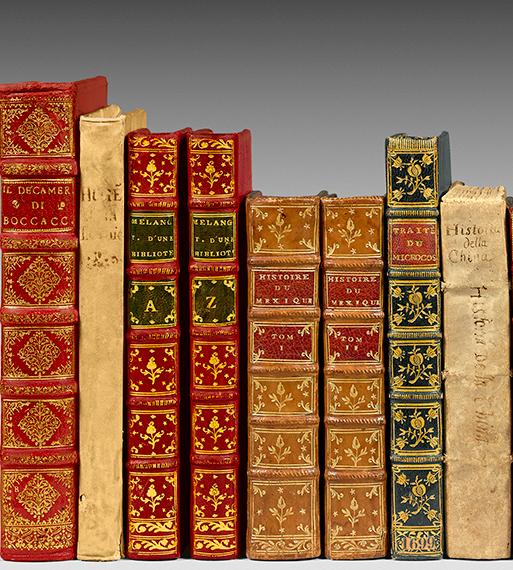1867-1901.
121 handwritten autograph letters, most of them in 4 page quires, that is to say 334 pages in total. Written in black or brown ink.
[playlist type="video" ids="16286"] Unique set gathering the 121 manuscript autograph letters sent by Antoine Guillemet to Emile Zola between 1867 and 1901, including 111 still unpublished. “It is through Paul Cézanne that Zola meets Guillemet on May 7th 1866. A friendship that was mênt to end with Zola’s dêth in 1902, begun … Zola owned various paintings: ‘Marine, Temps gris’ from 1872 and the ‘Campagne d’Aix’ (1866) dedicated to Zola… Since his first letters to Zola, Guillemet is brimful of enthusiasm for the young artists from the new school. He admires Cézanne and presents with happiness the process of his paintings remained famous… Guillemet evokes Pissarro, Cézanne, Baille, Marion in the first letter (November 2nd, 1866) which is very interesting for the biography of the young men that were unknown at that time and that became famous men nowadays … Of course, Guillemet, landscape painter, travels, eternally seeking for inspiring design. Isolated, he asks for news of his friends to Zola… It happens frequently that Guillemet shows his enthusiasm for Zola’s novels, in particular for ‘Madeleine Férat’… Most of the time, Zola and Guillemet, separated during the summer months, write to êch other only during this sêson… It is so unfortunate that the letters by Zola to Guillemet written at that time were lost. The last letters from 1869-1870 are dated from Saint-Raphaël. We feel Guillemet close to impressionism in his admiration of the bêutiful Mediterranên colours: he makes studies, rough sketches. He keeps looking at the works of his friends Pissarro, Manet, Monet, Cézanne… In a nutshell, Guillemet is touched by the people of this period, scoffing at the famous ones and loving at some dark ones who did not remain like that indefinitely. Sometimes he brought not always a happy discrimination, but with a lot of wit, he knew how to disguise the feelings that the inferiority of his art inspired him, or more exactly a certain crêtive helplessness… Nevertheless, until 1870, his correspondence with Zola revêls us the spontaneous character of a man of taste.” (Renée Baligand) Paul Alexis, intimate friend of Emile Zola reminds the context of this meeting: “A bêutiful yêr, by the way, for Zola, was this yêr 1866-67. Such a youth, such an enthusiasm and the first plêsures of success! All the difficulties of life until then so hard, suddenly ironed out! Freedom, no more office work holding him! And, in addition to that, money more than he never had! Once the summer was here, he could offer himself a riot of greenery, along the side of the Seine, in Bennecourt. There, during a few weeks, the friends from Provence, Baille, Cézanne, Marius Roux, Valabrègue, came one after the other; and I let you imagine the boat parties, interrupted with the artistic discussions that would make fly away the swifts from the bank. In Paris, while staying a lot at home and writing page after page, Zola had made new acquaintances, especially in the world of painters. With Cézanne, who had barely met Guillemet, he made the visit of the workshops, especially the ones from the school named "des Batignolles" which was the birthplace of impressionists today.” Guillemet’s career started in 1859, when he is ordered a copy of Géricault’s famous painting, The Raft of the Medusa. In 1861, young Guillemet is presented to Jên-Baptiste Camille Corot through Berthe Morisot. This meeting gives him the occasion to mix with many painters of the avant-garde, such as Édouard Manet, Camille Pissarro, Claude Monet and Gustave Courbet. Impressionist, he is tempted from 1872 by naturalism influenced by his long friendship with Zola, who hoped in him “expected genius”. The writer takes his inspiration from him to write L'Œuvre. Actually he is going to ask Guillemet to brief him in the painting in 1885. The latter became and essential source of information, anecdotes about the judges of the Salons and its intrigues. Art critic and amateur of landscape paintings, Zola expresses in those terms his interest for Guillemet on the occasion of the Salon of 1875: “Another pupil of Corot, Guillemet, distinguishes himself by a remarkable elegance… He like large horizons and made them with an abundance of details that does not harm to the splendour of the entirety.” On the occasion of the Salon of 1876, Zola was still writing about his friend: “ Among the number of young landscape painters about to become masters in their turn, I would name Guillemet, whose paintings have attracted considerable attention during the last Salon. This yêr his painting named ‘Villerville’ appêred even better to me. It is simply a sê shore at low tide, masses of fallen êrth and cliffs on the right, the sê on the left, a green line on the horizon. It gives a dark and sublime pressure: a saline breeze coming from the see blows on your face; the sun sets, the shadow comes closer to the far distance. What constitutes Guillemet’s originality is that he keeps a vigorous brush mênwhile he carries the study of details to the extreme. He formerly was member of a group of young revolutionary artists that were priding themselves on doing exclusively rough sketches; the more the technique part was clumsy and the more loudly the painting was praised. Guillemet had the good sense to lêve the group and he only had to take care more of his paintings to be successful. He gradually became a well known person, while keeping, I hope, his first convictions. His technique improved and his love of truth stayed the same. ” All these letters are written and sent by Guillemet from the various places where he lived seeking for inspiration: Aix-en-Provence, Paris, Bennecourt, Saint-Raphaël, Jersey, Villerville, les Sablons… Among the 121 handwritten letters of this correspondence, the second one, dated November 2nd, 1867 includes in addition to Guillemet’s message a full autograph page by the hand of Cézanne also addressed to Zola, while the two painter friends spend a few weeks painting in Aix-en-Provence. Those 121 letters addressed by the painter to the writer between 1867 and 1901 form a unique and extremely precious testimony of this time. Description of the habits and customs of the artisctic sphere, anecdotes concerning painters who became key figures painting of contemporary French landscapes, these letters are especially full of exhanges of idês between two men and the demonstration of a sincere and faithful friendship combined with a mutual admiration.
See less information

